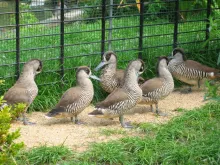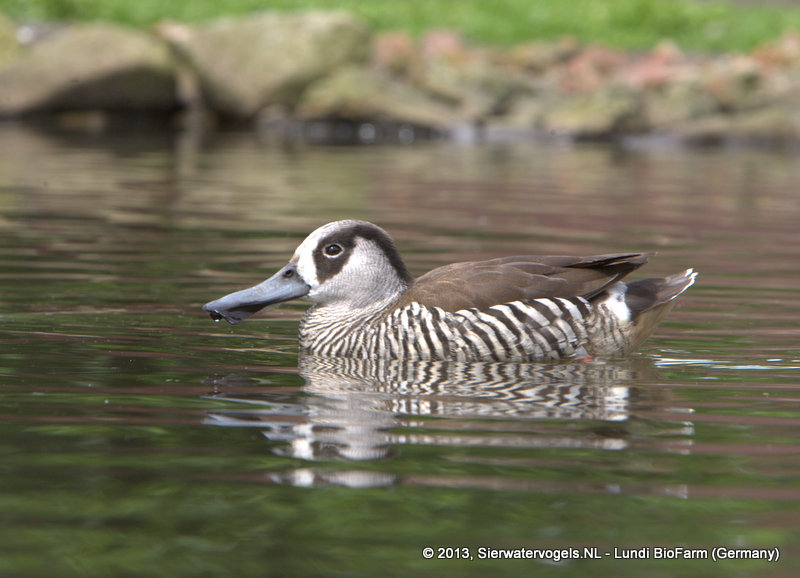
Pink-Eared Duck (Malacorhynchus membranaceus)
Species name
- Dutch name:
- Roze-ooreend
- English name:
- Pink-Eared Duck
- German name:
- Spatelschnabelente
- French name:
- Canard à oreilles roses
- Scientific name:
- Malacorhynchus membranaceus
Scientific classification
- Order:
- Anseriformes
- Family:
- Anatidae
- Onderfamilie:
- Anatinae
- Genus:
- Malacorhynchus
Description
- Description:
As its name suggests, the pink-eared duck also has a small pink patch of feathers behind the eye. This patch of feathers is unusual as it contains carotenoid pigments which are absent from the rest of the order Anseriformes.
Male:
It is a rather attractive duck, with striking dark brown and white feathers along its chest and flanks, giving it its alternative name the zebra duck. It has buff-brown feathers underneath its tail, brown wings and back, a white rump, white neck feathers, a white face with grey along the forehead and crown and a dark brown patch surrounding a narrow ring of white feathers around the eye.As its name suggests, the pink-eared duck also has a small pink patch of feathers behind the eye. This patch of feathers is unusual as it contains carotenoid pigments which are absent from the rest of the order Anseriformes.
Female:
Males and females are almost indistinguishable, with females being slightly smaller than males.Juvenile:
Juveniles are duller and browner than the adults.
- Behaviour:
In the wild Pink eared can nest in relatively close proximity to one another, from observations in captivity this always seems difficult to comprehend because the Pink eared is certainly a duck with attitude. They are a small teal sized bird that while not overly aggressive to other waterfowl will certainly not be pushed around. With other Pink eared they can be incredibly aggressive, they have a range of different calls and postures and if more than one pair is kept together there will be occasions when you will be amazed at the range off calls and postures a bird can make as they defend their patch of the enclosure. They are a very active duck and when in breeding condition they are either feeding or posturing and fighting with the neighbours.
Standard Measurements
- Body Length (cm):
- The male (drake) of the Pink-Eared Duck measures approximately 36-45 centimeters. The female measures approximately 36-45 centimeters.
- Body Weight (grams):
- The male will weight about 290-480 gram. The female will weight about 272-423 gram.
The weight is notoriously variable and can only be used as indication!
- Note:
Breeding in the wild as in captivity can occur at almost any time of the year, in the wild principal breeding takes place following heavy rainfall and floods. Rainfall is believed to be a primary precursor to breeding in the wild and may also be relevant in captivity, in captivity rainfall certainly triggers much excitement.
In captivity they will use a variety of nest boxes and have a slight preference for those that are actually over the water. Once a pair decide on a nest-box they will defend it with great gusto that is very amusing to watch. Clutches off quite pointed dull white eggs are relatively small and tend to range from four to eight with six being usual. The nest is lined with significant amounts of down that is quite different to most other waterfowl, it is very thick and has an almost sticky composition.
Pink eared eggs are relatively easy to incubate and hatch but then the challenge begins. Rearing them in a dry brooder would be ideal but this approach does not appear to work. Consequently they need to be reared with access to shallow water from day one. Feeding should initially take place on the water but trying to get the ducklings to take dry feed as quickly as possible. As ducklings they are incredibly messy feeders, one minute you can be looking at a cute fluffy little silver grey duckling and the next it has managed to completely smother itself in a gluey mess of wet crumb soup. Trying to clean them and stopping them from getting a chill at this stage can prove difficult. If this can be achieved then they grow and rear on in much the same way as any other waterfowl.
- Breeding:
- The female Pink-Eared Duck usually lays from 4-6 creamy white eggs and incubates them for 26 days.
- Artificial incubating:
The ideal relative humidity for incubating most waterfowl eggs is 55% (ground nesters) and 40% (cavity nesters). The temperature is usually 37.4°C. Set ventilation as recommended by the incubator manufacturer. Eggs must be turned, either automatically or by hand, a minimum of 4 times a day. As the duckling develops there is a loss of water from the egg and the air sac gets bigger. In normal development of an egg with a 26 days incubation, the air sac occupies about a third of it three days earlier. Cleanliness is vital and ideally eggs should be moved to a separate hatcher at this point, where the humidity should be increased to 65% and even higher once they have pipped internally.
- Bird banding:
- Recommended closed leg band ring size for the Pink-Eared Duck is 8 mm.The leg band ring can only be applied on a young small duck at around 12 days old.
- It doesn't matter what leg that you band, but it's good to have a consistent system. Suggested: Left leg = Female, Right leg = Male
- Rearingfeed:
-
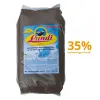
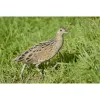

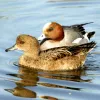


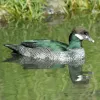 Floatable special rearing feed for all ornamental waterfowl species, even for problematic eaters. This ideally balanced complete feed with 35% protein content forms the basis for healthy growth and lifelong vitality. Made exclusively from wholesome and selected raw materials, Lundi Micro is also ideally suited for the year-round feeding of waterfowl.
Floatable special rearing feed for all ornamental waterfowl species, even for problematic eaters. This ideally balanced complete feed with 35% protein content forms the basis for healthy growth and lifelong vitality. Made exclusively from wholesome and selected raw materials, Lundi Micro is also ideally suited for the year-round feeding of waterfowl.
- Maintenance food:
-


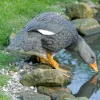
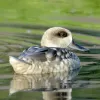
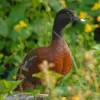


Floatable special complete food for sea birds with the highest nutritional requirements. Each chunk contains the complete nutrient spectrum. The high protein content of 35% ensures a healthy and species-appropriate diet. Spiral algae give a more magnificent coloration of plumage and sea salt promotes the salt gland.


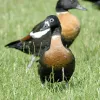


Floating full food for all sea ducks, green ducks, eider ducks and geese, especially in the moulting and breeding phase ideally suited. Packed with wholesome raw materials, natural vitamins and trace elements, this performance food with a protein content of 30% forms the basis for lifelong vitality.



